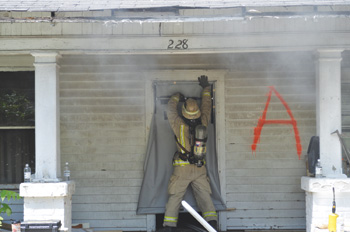By Robert Tutterow
Considerable discussions-i.e., arguments-have emerged in recent months about the changing fire environment and subsequent changes in fire attack. Almost everyone acknowledges that modern day construction along with modern day furnishings have increased the fire load and fire spread.
Concurrent with understanding the changing fire environment is researching improved methods of fire attack. At front and center of this discussion is the transitional fire attack. The transitional attack is the initial application of water from the outside before advancing a line into the interior. The mere mention of this approach usually elicits skeptical responses from firefighters. Yet there is a growing body of science that supports the transitional approach. The science is showing that it is not only a more effective approach for extinguishment but also a better approach for victim survivability and firefighter safety. Studies are ongoing, and I am not sure the body of evidence is complete or compelling enough just yet to call for a wholesale change in fire attack. The scary part of these discussions is the firefighters who say they don’t care what the science proves. It must be political season!
 |
| (1) Here, a firefighter deploys a portable door to control air track movement. (Photo by author.) |
Reading Air Movement
My very limited experience in the transitional approach was a research fire conducted in Albemarle, North Carolina, this past May. It was part of the “Kill the Flashover” project (www.joestarnes.com/kill-the-flashover-project-2012). The carefully instrumented and measured fire supported a form of the transitional attack. However, the premise of this research fire was more about air track management than transitional attack. The “Kill the Flashover” project is based on the book Smoke Burns, by John Taylor (www.smokeburns.com), who has extensive experience in fire behavior in the United Kingdom. However, much of his research and teachings stem from the Swedish fire service.
So what does all this have to do with equipment? Obviously, this remains to be seen. But, there might be a few leading indicators based on the work of the “Kill the Flashover” project. In trying to get a better understanding of air track movement and its impact on fire behavior-yes, there is an undeniable direct correlation-firefighters need to learn how to read air movement. A key tool for doing this is the thermal imager. There is a strong case that two (or more) thermal imagers are very useful-one for the interior crews (task level) and one for use on the exterior (big picture).
To grasp a better understanding of air track movement, firefighters must learn more about controlling air track movement. This goes beyond vertical or horizontal ventilation or positive pressure ventilation. It involves controlling air movement in various rooms of a structure. The “Kill the Flashover” project revealed new applications for positive pressure ventilation during fire attack. It involves the use of portable doors. A Swedish idea, the portable door is simply a cargo stabilizer bar attached to a flame retardant fabric. The cargo bar is installed in a door opening to control air movement. It is cheap and easily deployable.
Another tool that makes a huge difference in firefighter safety is PyroLance’s ultra-high-pressure technology. I had an opportunity to witness the PyroLance piercing nozzle a couple of months ago and was very impressed. In addition, the company’s PyroBlitz nozzle is also an interesting tool for the changing fire environment.
Turnout Gear
With a changing fire environment and possible changes in fire suppression, there might be a need to look at a change in personal protective equipment (PPE). The “Kill the Flashover” project research fire showed an interesting concept in turnout gear from Prince William County fire instructors. Their turnout coats had an attached thick hood (think hoodie) that fit over their small-brimmed helmets. The instructors stated that the hood kept their heads cooler (literally) and they did not have the headaches normally associated with traditional gear after a day of live fire burns. One of the instructors said the Swedish don’t understand why we protect our butts better than we protect our heads!
As stated earlier, I am not sure the body of evidence is complete or compelling enough to call for a wholesale change in fire attack or equipment. It is very promising. However, I am a very strong advocate for the continued research and study into the changing fire environment, changes in fire attack, and changes in firefighting equipment. And if we don’t like what the science tells us, are we sure the earth’s not flat?
From a firefighter safety perspective, it seems that Life Safety Initiatives 1, 3, 7, 8, and 16 are applicable to this discussion.
ROBERT TUTTEROW retired as safety coordinator for the Charlotte (NC) Fire Department and is a member of the Fire Apparatus & Emergency Equipment editorial advisory board. His 34-year career includes 10 as a volunteer. He has been very active in the National Fire Protection Association through service on the Fire Service Section Executive Board and technical committees involved with safety, apparatus, and personal protective equipment. He is a founding member and president of the Fire Industry Equipment Research Organization (F.I.E.R.O.).

